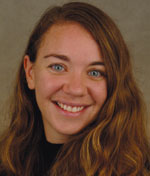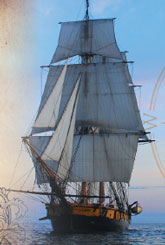|
For years, Dr. Sherri “Sam” Mason has encouraged people to reduce the plastic they consume. A chemistry and biochemistry professor and the coordinator of Fredonia’s Environmental Sciences program, she has urged students and community members to avoid products that either contain or are sealed in plastic, and eliminate plastic shopping bags.
Plastic doesn’t biodegrade, she explains. As much as 50 percent of it never winds up in a landfill. Instead, it becomes part of our ecosystem, entering our animals, plants, soil, water and – ultimately – us.
This summer, she decided to show people exactly what she means.
From July 11 to 31, Dr. Mason, in collaboration with the 5 Gyres Institute, led the first-ever survey of plastic pollution in the Great Lakes. Together with students and faculty researchers from Fredonia and other Great Lakes-based universities, she collected samples which will be used to formulate an analysis from the team’s findings later this year.
They will attempt to quantify the amount of plastic polluting the largest group of fresh water lakes on Earth. The study also intends on raising regional awareness of how much plastic is filtering in and out of our open waters.
With roughly 35 million people residing within the more than 94,000-square-mile Great Lakes ecosystem, along with the well-known abundance of plastic in the world’s oceans, Dr. Mason and her colleagues have reason to believe that substantial plastic debris will be found.
“Roughly 80% of plastic debris found in the oceans comes from land,” said Mason when the project was initially announced in the spring. “The Great Lakes comprise a flow-through water system and empty into the ocean. If our hypothesis holds true, we should find significant amounts of plastic debris here as well.”
The magnitude of this three-week endeavor was immediately apparent to outsiders, attracting news media across the nation, including an Associated Press article which appeared in The Wall Street Journal when the project was announced and an in-depth public radio report in the days leading up the team’s departure.
As an added perk, the researchers rode in style. They sailed west across lakes Superior, Huron and Erie on board the Flagship Niagara, an Erie, Pa.-based replica of Commodore Oliver Hazard Perry’s victorious Battle of Lake Erie vessel from the War of 1812 (coincidentally, during the war’s bicentennial). They lived on the ship and slept in hammocks. Meals were cooked on a wood-burning stove. The team was taught how to sail the ship and participated in a variety of daily activities.
The project was made possible through a partnership with 5 Gyres, an organization which has surveyed all five major oceans and seen this pollution first-hand. It strives to bring awareness to the global issue. The project was also awarded a $10,000 grant from the Burning River Foundation, a Cleveland, Ohio-based entity dedicated to improving, maintaining and celebrating the vitality of the region’s freshwater resources. The team used a “manta trawl,” a net system used for sampling the surface of a body of water for debris.
Many aquatic species become endangered as the amount of plastic spreads throughout bodies of water, according to Mason. Products such as bags and beverage containers make their way into our lakes, rivers and streams. In the process they become fragmented under the action of water. Marine animals can become entangled or eat these fragments thinking that they are food. Researchers have estimated that plastic leads to the deaths of a million aquatic animals annually.
“The world is an interconnected system. This is not just about aquatic animals; it is a significant concern to human health as well,” explained Mason, who has led a variety of other environmental and sustainable initiatives on and off campus over the past several years.
During one of the group’s first stops in Marquette, Mich., they conducted surveys at two different beaches. Both had plastic debris present, including “nurdles,” or pre-production plastic particles. They also discovered a “plastic graveyard” of debris about 50 meters off Middle Bay beach – an algae growth a couple of meters wide mixed with a plethora of plastic waste.
For the students involved like Hannah Farley, this expedition offered an unparalleled experience. Its significance was not lost on this member of the Class of 2013.
“It’s pretty impressive,” said Farley. “We are at the forefront of scientific research of our generation. What we find here could change the way the Western World perceives the ‘single-use-plastic’ lifestyle of today.”





